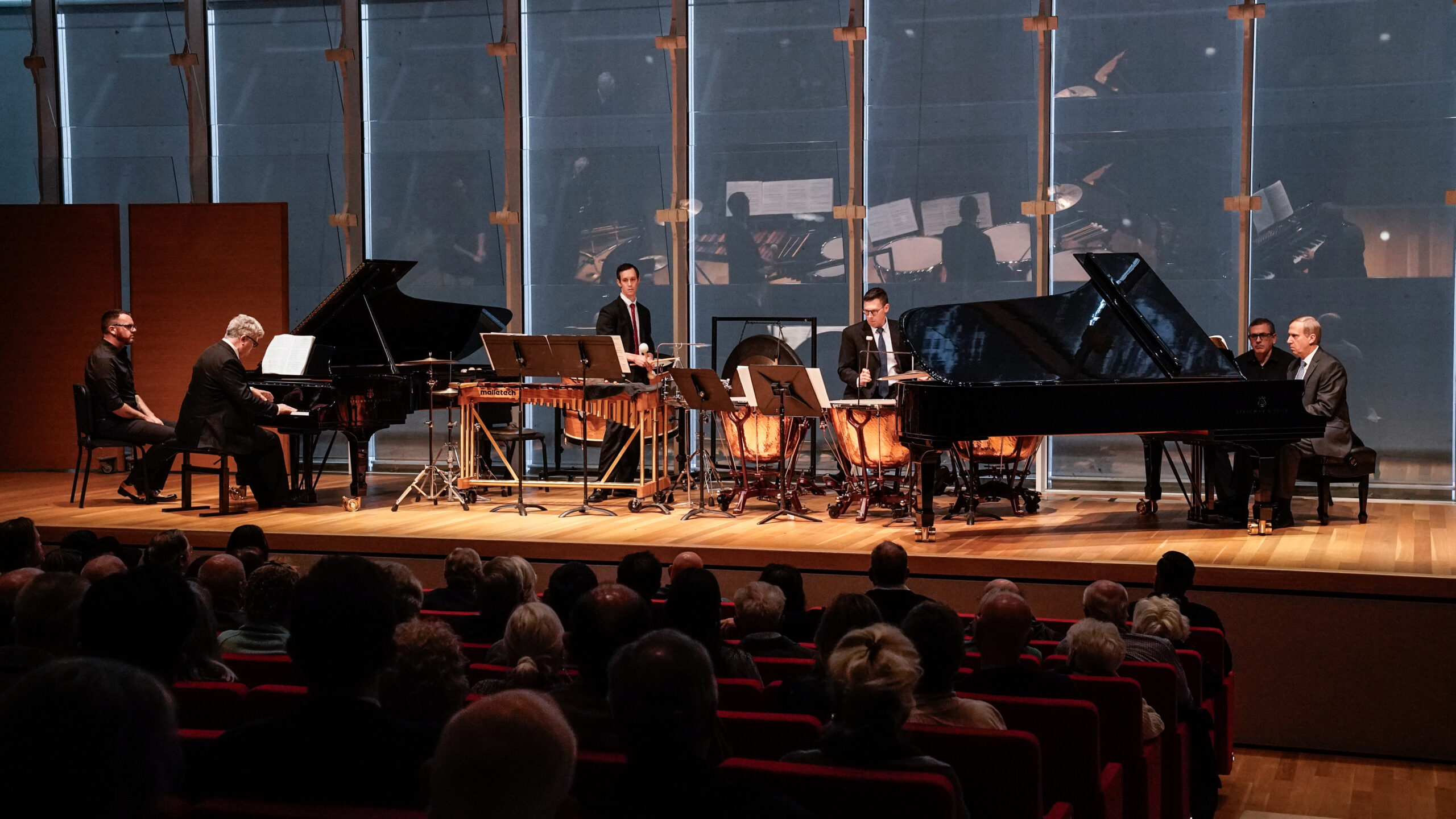
Leading with a Vision: Fort Worth Symphony Orchestra’s CEO looks back at the challenges faced and milestones reached during his first five years
By Tori Couch
Photography by Ralph Lauer
Keith Cerny tried hiding a smile.
Sitting inside the Fort Worth Symphony Orchestra’s boardroom in early November, Cerny recounted the challenges faced and milestones reached during his first five years as the symphony’s CEO and president.
Cerny, 61, celebrated the anniversary Jan. 11. His driven, focused personality was on display while talking about the job and the hurdles ahead. The smile snuck in when Cerny talked about a piano performance he played last fall.
“It’s great fun,” he said. “I mean, I won’t deny that.”
Cerny played “Bartok’s Sonata for Two Pianos and Percussion” with principal pianist Buddy Bray, a 38-year symphony veteran, at an October Chamber Series performance.
The piece required months of preparation, but Bray and Cerny rehearsed together just three or four times the week before the concert, Bray said. Each rehearsal lasted a couple hours.
“He wanted to play one of the very most difficult pieces in the repertoire for two pianos and percussion,” Bray said. “And so, by God, we did.”
Cerny had performed with symphony members before, recording a couple of performances for online use. Michael Shih, the symphony’s concertmaster/violinist, and cellist Allan Steele joined Cerny to perform “Beethoven’s Piano Trio.” Cerny and Robert Spano, then the principal guest conductor, recorded Igor Stravinsky’s “Rite of Spring” during the COVID-19 pandemic.
Cerny started playing the piano as a child and planned to pursue a career as a musician, but switched to administration in his mid-20s while studying in London.
After spending several years in business and receiving an MBA from Harvard and a PhD in econometrics and development policy from The Open University in the United Kingdom, Cerny shifted to music administration. Cerny served in executive positions at the San Francisco, Dallas and Calgary operas before joining the FWSO in January 2019.
Performing with musicians became part of his leadership strategy over the years.
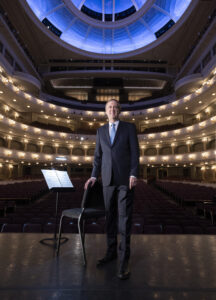
“It’s very easy to talk about performing, but when you actually stick your neck out and have to play, you remind yourself that it takes a lot of preparation, a lot of discipline,” Cerny said. “I think it really helps establish rapport with musicians.”
When Cerny arrived, one of his first projects was finding a new music director to succeed Miguel Harth-Bedoya, whose 20 years ended after the 2019-20 season.
But the global pandemic interrupted that search. His focus shifted to finding a new venue in which to safely perform while keeping the symphony financially stable. Cerny managed all that while recruiting and hiring Spano, a renowned music director who spent 20 years directing the Atlanta Symphony Orchestra. Together, Cerny and Spano have re-envisioned the symphonic series with a concept called “Theater of a Concert.”
Fundraising, keeping a balanced budget and expanding the symphony’s reach, which includes growing the organization’s board and performing in different venues, are among Cerny’s responsibilities.
“He’s a man of a certain quality, therefore, I expected him to do well,” Mercedes T. Bass, the symphony’s chair, said. “I was always hoping we would find somebody in the class of Keith.”
Finding Cerny required a bit of luck. The president and CEO position for the symphony opened in July 2017 when Amy Adkins left. The symphony’s board interviewed more than a dozen candidates. Then, a friend of Bass presented a potential candidate. Cerny’s resume and skill set checked every box.
“He seemed too good to be true,” Bass said. “We interviewed him and we hired him right away.”
At the time, Cerny was working in Calgary while his wife, Jennifer, and their sons lived in Dallas. The commute had become unsustainable, Cerny said. He left Calgary for Fort Worth after one year.
Bass’ vision for the symphony drew Cerny to the job, he said.
“She had described her objectives as really wanting to put the Fort Worth Symphony on the map before she stepped down, and that really appealed to me a lot,” Cerny said. “I like working for leadership that has ambition and focus, so that was definitely a big plus of the position.”
Cerny immediately started implementing a new vision.
An administrative change Cerny made early on was adding a human resources position. Jacque Carpenter became an invaluable resource for the staff and musicians and helped develop health and safety protocols for the pandemic.
“It’s been essential to have her,” Bray said. “I don’t know how we got along without her, but that was one of Keith’s innovations.”
Shih noted that Carpenter “has just put so many things in perspective.”
Carpenter is now vice president of human resources, and the symphony has added an HR coordinator.
Another initiative centered around increasing board membership. Board member Aaron Howard noted the board’s size had dropped to one of its lowest points around the time of the COVID-19 pandemic. Howard has served on the board since 2014 and joined the executive committee in 2017.
Adding more board members, whom Cerny calls the symphony’s “ambassadors,” plays into his larger vision of expanding the symphony’s presence. As of mid-January, Cerny had recruited 37 new board members.
“It was a thoughtful, conscious decision,” Howard said. “Keith brought this up in board meetings, talked about the number of people on the board in the past, and even set some growth targets.”
But the pandemic was the biggest challenge Cerny faced. Performance venues closed and ticket sale revenue disappeared. Many organizations wondered how or if they could keep employees on payroll.
The symphony received $8.1 million in government assistance — including from the federal Paycheck Protection Program — which covered payroll, along with donor contributions. The aid ended with the 2021-22 season.
“I worked very closely with the board chairman and the board to preserve the wonderful asset that had been developed over decades, namely our musicians and our staff,” Cerny said.
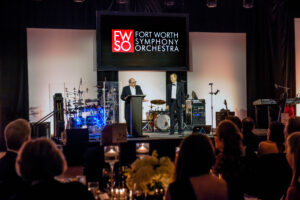 Howard credits Cerny’s foresight and business mindset for how the symphony garnered government funding. Cerny started thinking about possible outcomes related to COVID before the shutdowns occurred, Howard said.
Howard credits Cerny’s foresight and business mindset for how the symphony garnered government funding. Cerny started thinking about possible outcomes related to COVID before the shutdowns occurred, Howard said.
“COVID was an extreme nobody really saw coming,” Howard said. “But working through paperwork and other ways to mitigate the risk that if COVID would come over here and shut all the performances down, that set the symphony up well to get the funding that it did.”
Performing live set the orchestra apart from other organizations, too. Bass Hall — the symphony’s home — did not reopen for the 2020-21 season, so performances moved to Will Rogers Memorial Auditorium.
The season looked very different. Musicians sat six feet apart, with plexiglass separating each row. Monitors helped the musicians hear other instruments while the conductor addressed the orchestra using a microphone.
Bray served as chair of the orchestra committee during the pandemic and spoke with Cerny weekly.
Cerny “wanted to keep the lines of communication open,” Bray said. “He wanted me to know exactly what he was involved in doing to try to keep the lights on, so to speak.”
Cerny also held weekly calls with the president of the musicians union in North Texas.
“I really enjoyed that process,” Cerny said. “It opened up a whole new area to talk about safety policies on stage and new opportunities to build consensus within their membership and how musicians and administration were going to work together.”
Cerny continues to regularly meet with committee members, said Bray, who has since rolled off of the committee.
Before the 2020-21 season ended, the symphony announced Spano had accepted the music director position. He became the symphony’s 10th music director in August 2022.
Cerny’s ability to keep the symphony moving ahead, despite a once-in-a-century experience, was “superhuman,” Bray said.
The momentum also changed the post-pandemic conversations surrounding the symphony.
“It would be all recovery from COVID, not this vision for the future and path forward,” Howard said.
The symphony gradually added more to its season, reaching 12 symphonic concerts during the 2023-24 season. The symphony has added a musician to the core orchestra each year, as well, a trend Cerny said he wants to continue over the next few years.
Cerny and Spano also started implementing a new artistic vision. In the symphonic series, the “Theater of a Concert” concept focuses on increasing audience engagement by adding more visual and contextual elements and enhancements like interviewing a composer on stage.
“The thing that I find really exciting, and I think we’re rapidly building a national reputation for, is the innovation that we’re bringing into the symphonic experience,” Cerny said.
During last season’s performance of “Haydn: The Creation,” singers moved around on stage while images related to the song’s lyrics were projected on screens and a draped sheet. An English translation was provided above the stage.
The symphony and dancers have shared the stage as part of a three-year Stravinsky ballet series that continues next season. Texas Ballet Theater performed “Firebird” with the symphony last season, and Dallas Black Dance Theatre collaborated on “Petrushka” in January.
Bray said the opera backgrounds of Cerny and Spano make them the ideal duo to plan and execute large-scale, labor-intensive collaborations.
“Everything has to be pretty much set before we get to the first orchestra rehearsal,” Bray said. “There’s no time, really, once we get into rehearsal for things to be adjusted too much. It has to be pretty well done right there, but Keith is so used to that because he worked in opera.”
Cerny worked with the Dallas Black Dance Theatre while he worked for the Dallas Opera. The collaboration with the symphony helped the theatre build its audience and engage more with Fort Worth, Zenetta Drew, DBDT’s executive director, said. Dallas Black Dance Theater performs annually at Fort Worth’s W. E. Scott Theater through a series called Dancing Beyond Borders.
Performing to live music brought another unique element for the dancers, she said.
“This gives them an ability to challenge themselves, to showcase the true artistry that comes from engaging in the moment with your craft and with the music,” Drew said. “I think that’s what was most compelling to us.”
The Old Trout Puppet Workshop, a Calgary-based puppeteer group, helped the symphony tell the story of “Peter and the Wolf” last fall. The musicians know the piece well since it is performed every year as part of Performing Arts Fort Worth’s children’s education programming.
The puppeteers used a pop-up book concept during the piece, giving it a different meaning for the musicians.
“It brought the story a whole new dimension that we had never, even in our wildest dreams, had imagined,” Shih said. “It was great and it was so well received.”
Partons of all ages filled Bass Performance Hall with laughter.
“So many families showed up there, and that just added a whole other layer of fun and excitement across the theater,” Howard said. “It was pure fun. That vision is working to engage others, bring them into the fold and hopefully that leads to additional [ticket] sales.”
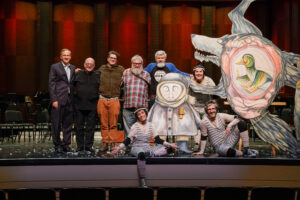 Visual elements are used in the pops and specials series as well. The upcoming “Star Wars: The Empire Strikes Back” show will have movie clips playing while the orchestra performs the score. A 3D motion sculpting technology will display paintings from 14 artists during the “Lasting Impressions” show.
Visual elements are used in the pops and specials series as well. The upcoming “Star Wars: The Empire Strikes Back” show will have movie clips playing while the orchestra performs the score. A 3D motion sculpting technology will display paintings from 14 artists during the “Lasting Impressions” show.
The symphony recently released its 2024-25 season programming. It features 10 symphonic weekends, starting Sept. 6-8 with Tchaikovsky’s “Sixth” and Sibelius’ “Violin Concerto.” Other symphonic highlights include the world premiere of composer Jake Heggie’s “Earth 2.0,” Atlanta-based gloATL dancers collaborating on Stravinsky’s “The Rite of Spring,” and a semi-staged production of Wagner’s “The Flying Dutchman” with six world-class opera singers.
Pop series performances include “Kings of Soul,” with music by legendary artists like Marvin Gaye and The Temptations, and “Indiana Jones and the Raiders of the Lost Ark.” The specials series includes “Frozen in Concert” and “Black Panther in Concert.”
“Every piece is picked for a reason,” Cerny said. “There’s that whole creative process around the programming side with the goal that we feel like we’re showcasing all the different things the symphony can do.”
The Chamber Series at the Kimbell Art Museum will continue next season with three concerts. The series provides the symphony a place to perform music meant for a more intimate setting.
Cerny, Spano and musicians from the symphony have performed in the 280-plus seat Renzo Piano Pavilion over the past few seasons.
Eric Lee, director of the Kimbell since 2009, has watched the symphony evolve under Cerny. Lee said Cerny’s background as a musician and businessman makes him uniquely positioned to guide the symphony.
“You have to have that inspiration from the creative side, or else you know you can’t serve the mission of the organization, whether it’s a museum or a symphony,” Lee said. “Keith having expertise in both of those realms, you can say he’s both right-brained and left-brained, he’s an ideal person to lead the symphony.”
Inside the symphony offices, a red sign hangs with a quote from Henry Ford that reads “Coming together is a beginning, keeping together is a process, working together is success.”
Bass referenced the sign while talking about what Cerny has added to the symphony’s culture, such as how he’s encouraged new ideas from department heads and seeks their assistance.
“You really feel that he’s got the collaboration going between all of them,” she said.
This collaborative mindset guided the symphony through a difficult season for performing arts organizations and will remain important moving forward.
While the symphony emerged from the pandemic relatively unscathed, the post-pandemic era has brought new obstacles. Live performances returned, but ticket sales have taken a hit.
“I think we’re facing a lot of the same challenges many other symphonies are facing, specifically in ticket sales,” Cerny said. “What happened after 9/11 and the Great Recession [of 2008] and, I fear, COVID, is that there’s been a stair step down on subscriptions. People have migrated more and more to want to go to exactly what they want to go to and then purchase later and later.”
Operating costs have increased as have new contracts for musicians and stage crew members, among other things, putting more pressure on finances. The symphony maintained balanced budgets through the three pandemic-affected seasons, Cerny said.
The budget for 2022-23 was $15.1 million, compared to $14.4 million in 2021-22.
“Last year was a challenging year financially pulling out” of COVID, Cerny said. “Audiences were not coming back. I’m working a lot with our development team to broaden the support bases.”
Fundraisers, like the symphony’s upcoming annual gala and dinner featuring singers Renée Fleming and Rod Gilfrey, remain an important tool. The Cernys have hosted fundraisers at their home, with symphony musicians providing music.
Board members, musicians and staff are encouraged to invite friends, family and neighbors to performances and help grow the symphony’s reach by building interpersonal relationships.
“The answer for us going forward is continuing to make ourselves accessible and open to as many different parts of the community as we can,” Cerny said. “And particularly people who’ve been coming to us for many years, really celebrating that.”
Performing in venues outside Bass Hall provides the symphony another way to engage with the community.
Will Rogers Auditorium is used for one-night performances, such as last December’s Handel’s “Messiah” concert, or the upcoming “Lasting Impressions” show. The symphony performs an annual Christmas concert at Southlake’s White’s Chapel Methodist Church.
Concerts in the Garden, a popular summer series at the Fort Worth Botanic Garden, will pause for 2024 while the garden builds a permanent stage. The symphony instead will hold a series of summer concerts, including a series of chamber music at the Botanic Garden. A concert at the CR Smith Museum near Dallas/Fort Worth Airport will be part of the “Exploring Sounds Program,” and Arborlawn United Methodist Church will be the venue for a July 3 patriotic concert.
The symphony has strengthened its relationship with TCU, as well, Cerny said. Spano talks with TCU conducting students and the symphony has performed in the Van Cliburn Concert Hall at TCU. The symphony will perform “Storybook: Little Red Riding Hood” at TCU next season as part of the family series.
Engaging youth through education programming remains a priority for the symphony. I.M. Terrell’s varsity chamber orchestra performed side-by-side with symphony musicians in October as part of a partnership between the Fort Worth public schools and symphony. Another side-by-side concert with L.D. Bell High School in HEB ISD is planned for this spring.
Other programming includes onsite education concerts at Waxahachie ISD and Mesquite ISD elementary schools, the “Women of Texas” program at Bass Performance Hall for 3rd-6th graders, family concerts in partnership with I.M. Terrell dance academy and sixth graders to college students from all around DFW attending select open rehearsals.
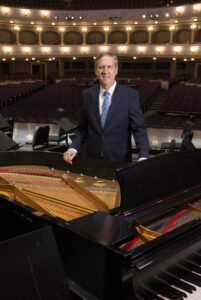 Every move made to expand the symphony’s reach has been purposeful, a consistent theme throughout Cerny’s tenure.
Every move made to expand the symphony’s reach has been purposeful, a consistent theme throughout Cerny’s tenure.
“He is an extremely thoughtful person,” Bray said. “He feels the weight of his responsibility. You get that from just talking to him. To have a person who is that serious and that thoughtful in that position, I think confers even more integrity and credibility on our product.”
When Cerny has a free moment, he might practice the piano, go for a run or take a vacation in New Mexico. The Cernys have a second place there where they can hike, enjoy the mountains and escape work.
Cerny also walks the family dog, a rescue Schnoodle named Libby. Libby joined the family in 2012.
“She’s getting elderly, but she’s just the most loving dog,” Cerny said. “She’s so grateful all these years afterwards to be fed and tickled behind the ears. It’s sweet.”
Libby has become an important part of the family. The Cernys’ four sons are out of the house — in college, graduate school or working — and send requests for videos or photos of Libby.
“They’ll actually call my wife and say I need a video; I need a Libby fix,” Cerny said. “Libby has been sort of the glue, I think, in many ways for the family.”
It’s possible the symphony views Cerny similarly – the glue that kept everyone together through an unprecedented experience and helped the symphony become a trailblazer of sorts.
“I don’t know how much more [Keith] can do,” Bass said. “He’s at the very top of my expectations.”
